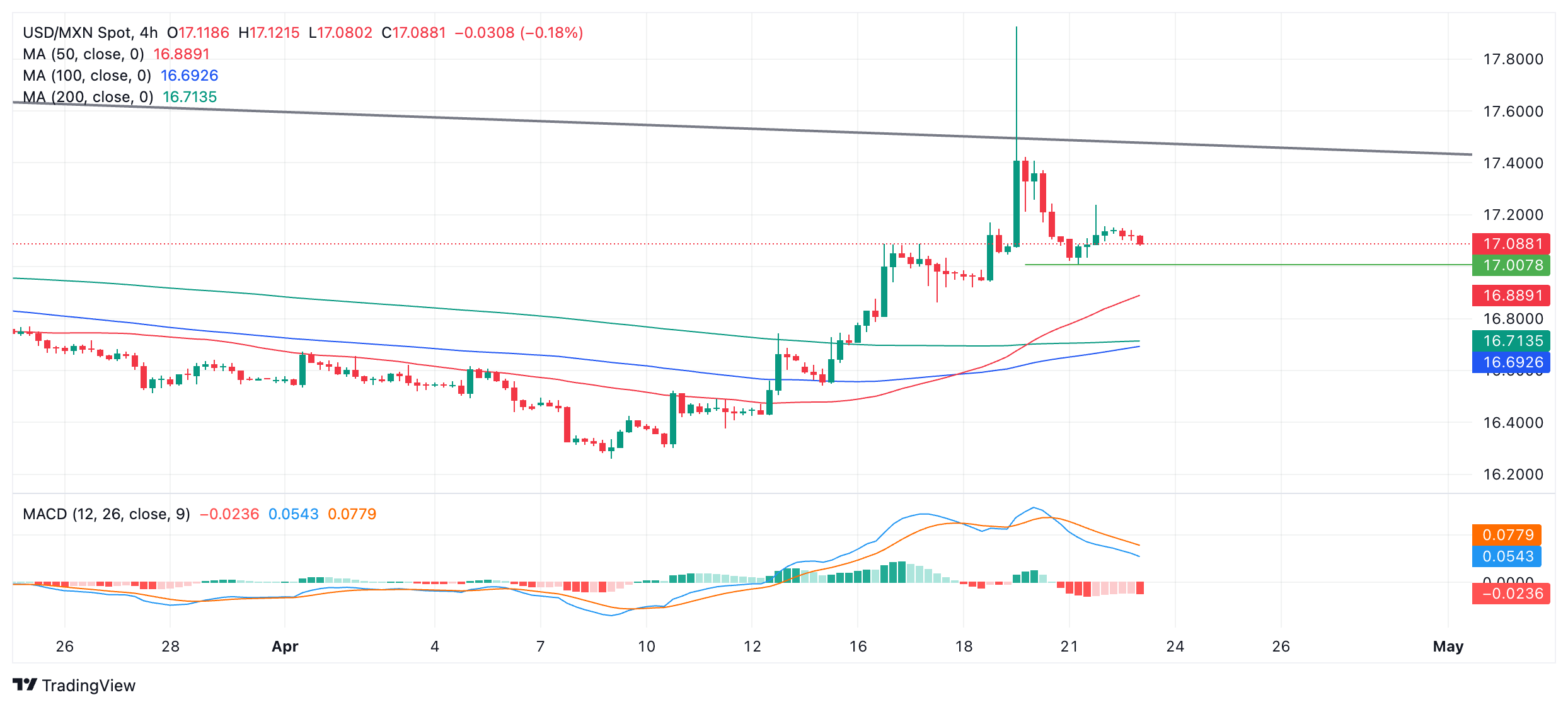The Mexican Peso trades mixed as global Purchasing Manager Indices (PMI) for April are released.
Mexican Economic Activity data failed to inject much volatility into the Peso on Monday.
The short-term uptrend looks vulnerable to breakdown.
The Mexican Peso (MXN) is trading mixed on Tuesday after plummeting temporarily at the end of last week, but then reverting to mean after fears of an escalation in the conflict in the Middle East abated.
Mexican Peso shrugs off macro data
The Mexican Peso did not gain much traction on Monday despite the release of better-than-expected macroeconomic data for February. Economic Activity rose 1.4% MoM and 4.4% YoY in the second month of the year compared to January’s 0.9% and 1.9% increases, respectively, according to data from the Instituto Nacional de Estadistica, Geografia e Informatica (INEGI).
Other news relevant to MXN included comments from Banxico Governor Victoria Rodriguez Ceja, who said that services inflation is not showing a clear downward trend.
Rodriguez Ceja added that the Mexican Peso’s strength has, at times, helped contain inflation by lowering the cost of imported goods.
Her comments reinforce the view that the central bank will be data dependent in its approach to monetary policy going forward.
In March, Banxico cut interest rates by 0.25% for the first time in three years after inflation showed progress lower. The minutes of the meeting, however, showed a lack of conviction about whether inflation had fallen in a sustainable fashion. This suggested another cut at their next meeting in May is not guaranteed.
Mexican mid-month inflation data for April, out on Wednesday, could adjust expectations for the Banxico’s policy approach going forward.
Mid-month inflation in March stood at 4.48% for headline and 4.69% for core YoY, and 0.27% and 0.33%, respectively, on a monthly basis.
A higher-than-previous result is likely to further lower the probability of the central bank following up the March rate cut with another cut in the near term, and vice versa for a lower-than-previous result.
Interest rates are a major driver of Forex markets. Higher interest rates appreciate a currency by attracting more inflows of foreign capital and the opposite for lower interest rates.
Tuesday also sees the release of key global macroeconomic data in the form of April Purchasing Manager Indices (PMI) for most major economies (although Mexico’s PMIs are not scheduled for release until May 2).
Eurozone PMIs have already been released and showed mixed results, with gains in Services but a deeper-than-forecast decline in Manufacturing PMI.
S&P Global PMIs for the US are scheduled for release at 13:45 GMT and could inject volatility into markets, especially for the most heavily traded MXN pair the USD/MXN.
Technical Analysis: USD/MXN short-term uptrend vulnerable
USD/MXN continues to trade below a major trendline for the long-term downtrend, despite briefly breaking above the line last week during the highly volatile reaction to the Israel-Iran conflict.
The brief piercing of the trendline and spike higher reversed the short-term and intermediate-term downtrends but not the longer-term trend, which remains bearish.
USD/MXN 4-hour Chart

A closer look at the 4-hour chart shows that the new short-term uptrend is vulnerable. A break below Monday’s 17.01 swing low would bring the short-term uptrend into doubt.
The Moving Average Convergence/Divergence (MACD) has crossed its signal line, giving a sell signal and is falling in line with price, overall painting a bearish picture.
If a pullback persists, support from the 100-day SMA at 16.96 followed by the 50-day SMA at 16.82 is likely to provide a foothold for the backsliding price.
A decisive break above the trendline at roughly 17.45 would provide bullish reconfirmation and activate an upside target at roughly 18.15.
A decisive break would be one characterized by a longer-than-average green daily candlestick that pierces above the trendline and closes near its high, or three green candlesticks in a row that pierce above the level.
Mexican Peso FAQs
The Mexican Peso (MXN) is the most traded currency among its Latin American peers. Its value is broadly determined by the performance of the Mexican economy, the country’s central bank’s policy, the amount of foreign investment in the country and even the levels of remittances sent by Mexicans who live abroad, particularly in the United States. Geopolitical trends can also move MXN: for example, the process of nearshoring – or the decision by some firms to relocate manufacturing capacity and supply chains closer to their home countries – is also seen as a catalyst for the Mexican currency as the country is considered a key manufacturing hub in the American continent. Another catalyst for MXN is Oil prices as Mexico is a key exporter of the commodity.
The main objective of Mexico’s central bank, also known as Banxico, is to maintain inflation at low and stable levels (at or close to its target of 3%, the midpoint in a tolerance band of between 2% and 4%). To this end, the bank sets an appropriate level of interest rates. When inflation is too high, Banxico will attempt to tame it by raising interest rates, making it more expensive for households and businesses to borrow money, thus cooling demand and the overall economy. Higher interest rates are generally positive for the Mexican Peso (MXN) as they lead to higher yields, making the country a more attractive place for investors. On the contrary, lower interest rates tend to weaken MXN.
Macroeconomic data releases are key to assess the state of the economy and can have an impact on the Mexican Peso (MXN) valuation. A strong Mexican economy, based on high economic growth, low unemployment and high confidence is good for MXN. Not only does it attract more foreign investment but it may encourage the Bank of Mexico (Banxico) to increase interest rates, particularly if this strength comes together with elevated inflation. However, if economic data is weak, MXN is likely to depreciate.
As an emerging-market currency, the Mexican Peso (MXN) tends to strive during risk-on periods, or when investors perceive that broader market risks are low and thus are eager to engage with investments that carry a higher risk. Conversely, MXN tends to weaken at times of market turbulence or economic uncertainty as investors tend to sell higher-risk assets and flee to the more-stable safe havens.
Information on these pages contains forward-looking statements that involve risks and uncertainties. Markets and instruments profiled on this page are for informational purposes only and should not in any way come across as a recommendation to buy or sell in these assets. You should do your own thorough research before making any investment decisions. FXStreet does not in any way guarantee that this information is free from mistakes, errors, or material misstatements. It also does not guarantee that this information is of a timely nature. Investing in Open Markets involves a great deal of risk, including the loss of all or a portion of your investment, as well as emotional distress. All risks, losses and costs associated with investing, including total loss of principal, are your responsibility. The views and opinions expressed in this article are those of the authors and do not necessarily reflect the official policy or position of FXStreet nor its advertisers. The author will not be held responsible for information that is found at the end of links posted on this page.
If not otherwise explicitly mentioned in the body of the article, at the time of writing, the author has no position in any stock mentioned in this article and no business relationship with any company mentioned. The author has not received compensation for writing this article, other than from FXStreet.
FXStreet and the author do not provide personalized recommendations. The author makes no representations as to the accuracy, completeness, or suitability of this information. FXStreet and the author will not be liable for any errors, omissions or any losses, injuries or damages arising from this information and its display or use. Errors and omissions excepted.
The author and FXStreet are not registered investment advisors and nothing in this article is intended to be investment advice.
>>> Read full article>>>
Copyright for syndicated content belongs to the linked Source : FXStreet – https://www.fxstreet.com/news/mexican-peso-trades-mixed-as-pmis-test-health-of-global-economy-202404230931































